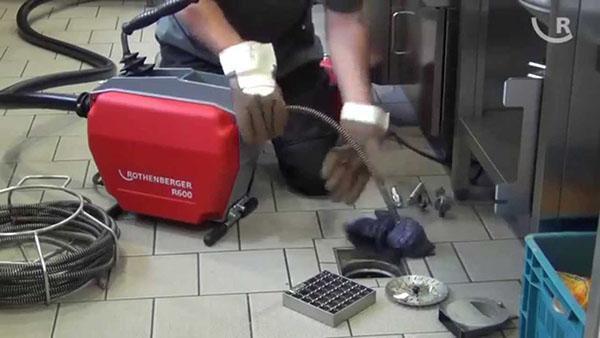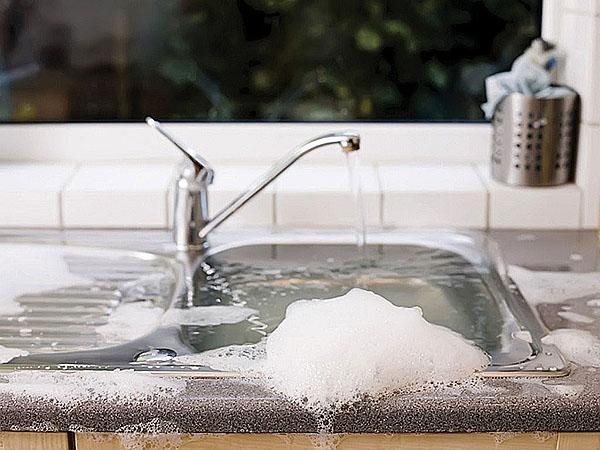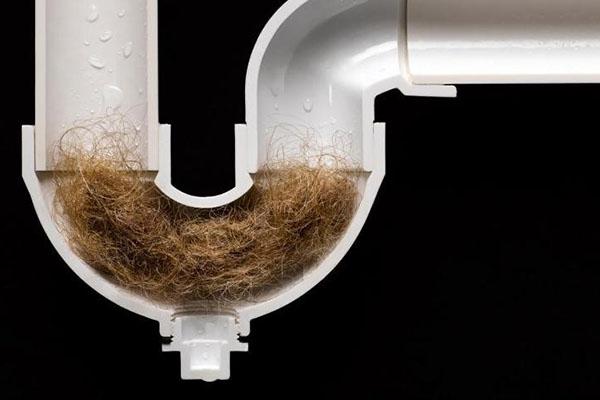How to unclog a sewer using different methods
 How to clean the sewer on your own? This question was asked by everyone who at least once faced the challenge of a professional plumber when a household wastewater drainage system fails. This publication is devoted to an overview of the most effective ways to self-eliminate blockage in the sewer system.
How to clean the sewer on your own? This question was asked by everyone who at least once faced the challenge of a professional plumber when a household wastewater drainage system fails. This publication is devoted to an overview of the most effective ways to self-eliminate blockage in the sewer system.
Signs of clogged sewer pipes

Determine the location of the blockage
 Before removing the blockage in the sewer, you should determine the place where the "plug" appears.
Before removing the blockage in the sewer, you should determine the place where the "plug" appears.
You should know that pipes are most often clogged in places of bends, and these are siphons and a comb.
Residents of an apartment building may face the problem of the formation of a "plug" in the sewer riser or the outlet pipeline. For ease of determining the location of the blockage in the waste and utility water drainage system, we suggest that you familiarize yourself with the table.
| Sign | Possible blockage location |
| Water does not leave one plumbing fixture, all the others work fine.
| Siphon sink, bath, shower. |
| The toilet works, water does not leave through some sinks. | "Cork" in the comb |
| Water obstruction through all plumbing fixtures, including the toilet | Blockage in the riser or "lounger" |
When detecting a blockage in a riser or a supply system, an emergency team should be called, which performs the work free of charge and at any time of the day. Experts know how to clean the sewer riser without allowing sewage to escape through the indoor plumbing fixtures.
Determine the cause of the blockage
 Determining where it was hammered is still half the battle. You need to know what contributed to the formation of a "plug" in the sewer pipe. This information is necessary in order to determine as accurately as possible how to break through the sewer in a private house and what chemicals to use to remove the blockage.
Determining where it was hammered is still half the battle. You need to know what contributed to the formation of a "plug" in the sewer pipe. This information is necessary in order to determine as accurately as possible how to break through the sewer in a private house and what chemicals to use to remove the blockage.
The most common reasons for the formation of "jams" in sewer pipes are mechanical blockages that appear due to the fault of the owner of the home:
- Thick paper. Cellulose tends to swell when exposed to water, which leads to a significant reduction in throughput in pipes.
- Food waste. Some waste practically does not dissolve, settles on the walls of the pipeline and overlaps the flow area of the sewer system devices.
- Textile. The rags end up in the sewer when the water is drained from the floors and hand wash.
- Hair. Experts consider hair to be the most common cause of blockages in bathrooms and showers.
There is another type of blockage - operational - arising during the operation of the sewer system. The main reason for the appearance of operational blockages is fat that adheres to the walls of the pipeline. It is to fat that all other contaminants adhere: hair, pet hair, cellulose, and so on. You will learn about ways to dissolve fat in pipes in the next section of this publication.
Eliminate the blockage in the sewer system

There are three methods for cleaning the sewer system:
- Thermal.
- Mechanical.
- Chemical.
 Do-it-yourself sewer cleaning with the thermal method involves the use of hot water to dissolve fat on the walls of the pipeline to increase the cross section and restore the system to work. Pour 2-3 liters of boiling water into the drain hole and wait for the water to drain.
Do-it-yourself sewer cleaning with the thermal method involves the use of hot water to dissolve fat on the walls of the pipeline to increase the cross section and restore the system to work. Pour 2-3 liters of boiling water into the drain hole and wait for the water to drain.
You should know that the efficiency of removing the blockage in the siphon by this method is very low. It's all about the water seal, the water in which will reduce the temperature of the liquid being poured, and, consequently, the efficiency of dissolving fat deposits.
 How to clean a sewer mechanically? With a rope, or a plunger. The cable breaks the plug, and the pressure drop created by the plunger pushes it into the wider part of the pipeline. This method is used for mechanical blockages: ingestion of rags, paper, debris, traffic jams created by food waste.
How to clean a sewer mechanically? With a rope, or a plunger. The cable breaks the plug, and the pressure drop created by the plunger pushes it into the wider part of the pipeline. This method is used for mechanical blockages: ingestion of rags, paper, debris, traffic jams created by food waste.
The chemical method involves the dissolution of fatty deposits with special chemical agents
Using a plunger to clear a blockage in a siphon
 The process of cleaning the sewage system in a private house begins with removing the blockage in the siphons of the sink, sink, bathroom and shower. As noted above, the most common causes of "obstruction" of water in plumbing fixtures - "plug" in the siphon and hair in the drain grate. It is quite simple to clean the siphon: you need to unscrew the lower part, remove dirt from the water seal, wash the dismantled element, and reinstall it.
The process of cleaning the sewage system in a private house begins with removing the blockage in the siphons of the sink, sink, bathroom and shower. As noted above, the most common causes of "obstruction" of water in plumbing fixtures - "plug" in the siphon and hair in the drain grate. It is quite simple to clean the siphon: you need to unscrew the lower part, remove dirt from the water seal, wash the dismantled element, and reinstall it.
In most cases, it is very inconvenient to disassemble the siphon. In this case, a plunger comes to the rescue:
- Take a plunger and press the rubber bowl firmly against the sink drain. Water must completely cover the plunger bowl to create a vacuum.
- Perform a few sudden back and forth movements with this device, which will create a pressure drop that pushes or destroys the plug.
The result of the plunger is the drainage of water through the drain hole.
Cleaning with a plumbing cable
 If the use of a plunger does not bring the desired effect, use a steel plumbing cable. It is with its help that professional plumbers remove trash plugs in household drainage systems.
If the use of a plunger does not bring the desired effect, use a steel plumbing cable. It is with its help that professional plumbers remove trash plugs in household drainage systems.
To clean the sewer with a cable, you must perform the following operations:
- We cover the floor at the work site with plastic wrap, which will protect the floor covering from contamination with fecal matter.
- We insert the cable into the pipe inspection window.
- We push it with rotational movements until it reaches the "plug", trying to destroy the blockage into fragments.
How to clear a strong blockage in the pipe if the work with the cable did not bring the desired results? The cable allows you to remove even the most serious dirt. Repeat this process several times, then pour a large amount of hot water into the system.
For cleaning metal sewer pipes, steel cables are used, which can have different diameters and lengths. Cleaning the plastic pipeline is carried out with soft spring cables that do not damage the walls of the pipeline.
 How to clean the sewer in the toilet if a homemade cable was ineffective? Use the factory version in the form of a flexible spiral that ends in a handle. To increase the efficiency of cleaning the toilet, many models are equipped with additional attachments in the form of a brush or hook.
How to clean the sewer in the toilet if a homemade cable was ineffective? Use the factory version in the form of a flexible spiral that ends in a handle. To increase the efficiency of cleaning the toilet, many models are equipped with additional attachments in the form of a brush or hook.
The use of chemicals
 How to break through the blockage in the sewer without using specialized tools and devices? The modern industry offers a very wide range of chemicals that can cope with severe fat deposits, dissolve hair and remove long-term soap deposits.
How to break through the blockage in the sewer without using specialized tools and devices? The modern industry offers a very wide range of chemicals that can cope with severe fat deposits, dissolve hair and remove long-term soap deposits.
According to the method of exposure, all funds are divided into two groups:
- Alkaline. Dissolve fatty deposits. The greatest efficiency was shown when cleaning the drainage system in the kitchen.
- Acidic. They are able to dissolve hair and remove soap deposits from the inner walls of sewer pipes. Most often, acidic agents are used to clean the sewage system in bathrooms.
Chemicals are available in the form:
- Powder and granule. It is convenient to pour into the drain hole. The most popular means: "Flup", "Potkhan".
- Gel. Coats the inner surface of the pipe, effectively affecting fat deposits. Domestic housewives trust Mr. Muskul and Tiret gels.
- Liquids. They have a high fluidity, localizing at the point of blockage. The "Mole" remedy is popular.
If you have a question of how to flush the sewer with a strong blockage, use liquid chemicals based on caustic soda.
How to unclog a sewer system
 Any chemical used to remove blockages from the drainage system is aggressive in nature. Alkalis and acids can damage the sewage material, harm health if they come into contact with the skin, mucous membranes and respiratory organs. That is why many families, especially those with young children, prefer to use the tools at hand that are in the kitchen of any housewife.
Any chemical used to remove blockages from the drainage system is aggressive in nature. Alkalis and acids can damage the sewage material, harm health if they come into contact with the skin, mucous membranes and respiratory organs. That is why many families, especially those with young children, prefer to use the tools at hand that are in the kitchen of any housewife.
The most popular folk remedy for blockages in pipes is a mixture soda with vinegar. When interacting, a violent thermal reaction occurs with the release of carbon dioxide. The mechanism of action of the "explosive" mixture is simple and effective. Due to the increase in temperature, fatty deposits are decomposed, and a large volume of carbon dioxide pushes the "plug" from the siphon into the discharge pipe with a large cross section. How to clean the drain with baking soda and vinegar? Put half a pack of baking soda into the drain hole, pour 0.5 liters of vinegar and carefully plug the drain with a stopper or rag. An hour later, pour several liters of boiling water into the drain hole, which will wash away the remaining fat and debris into the system.
The advantages of this method are undeniable. All ingredients are inexpensive and generally available in any kitchen. In addition, baking soda perfectly disinfects a section of the system, eliminating an unpleasant odor.